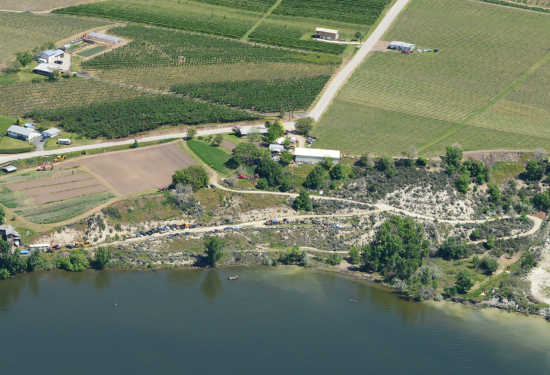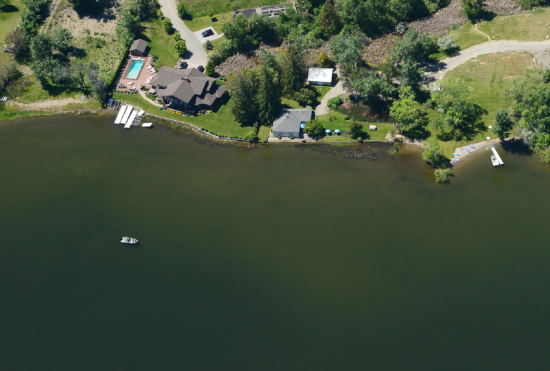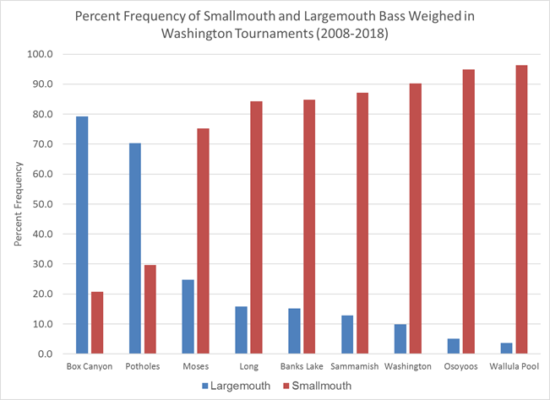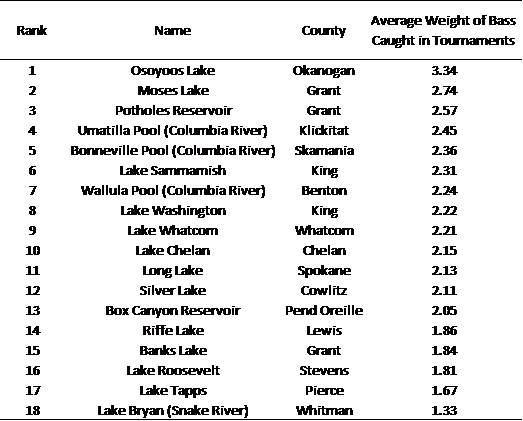
Why A Relatively Unknown Washington Lake May Produce The State’s Biggest Tourney Bass
If a WDFW staffer’s analysis of a decade’s worth of bass tournament catches spiked your interest in hitting Lake Osoyoos, we have a few more details to add about it and other hot spots.
That data posted to Facebook earlier this week showed that out of 18 waters across Washington, the fattest average fish was caught at this relatively overlooked border-straddling Okanogan River lake, 3.34 pounds — more than half a pound heavier than the next closest entry on the list.

“I suspect they are large in there because conditions are perfect and they have been left alone for the most part,” says Dr. Daniel Garrett, a state warmwater fisheries biologist now stationed in Spokane who crunched the numbers from 14 contests held there.
“I’m sure they would eat a sockeye smolt,” he adds, “but I’d be shocked if crawfish wasn’t driving their growth there for most of the year, as in other systems.”
No need to tell that to two Washington anglers who fished a tournament on the British Columbia side of the 5,729-acre lake last April.
They brought a monster smallmouth aboard that might have gone 9-plus pounds had it not been “pooping crayfish all over the deck,” according to an article on Bassfan.com.

It stated that the duo’s two-day, 64-plus-pound catch might also have been a record for the entire nation of Canada, though their final margin of victory — 39 pounds, 15 ounces — also suggests that they might have been fishing the spot on the spot on the spot.
The website reports they were dragging 4-inch Yamamoto Hula Grubs in cinnamon-purple flake and green pumpkin on 1/2-ounce football-head jigs around rocks next to weeds.
“This will put B.C. bass fishing on the map,” angler Shane Hoelzle told BassFan, which observed that otherwise, “largely because it’s a long drive from any large population center, and because anglers have kept quiet, Osoyoos remains largely unpressured.”
The lake is also on WDFW’s map, per se, and the agency says it offers “good fishing” from May through September, but ironically doesn’t list smallies in its rundown of “species you might catch” there.
At this writing, those spot-hoarding state zipperlippers only list perch, rainbows, kokanee, Chinook and sockeye as available.
But in Garrett’s analysis, Osoyoos actually had one of the highest percentages of smallmouth in its tourney catch, around 95 percent, topped only by the Mid-Columbia River’s Wallula Pool at roughly 97 percent.
Bronzebacks also comprised more than 70 percent of the bag at Lakes Washington, Sammamish, Banks and Long (Spokane), according to his analysis.

But largemouth dominated at two other waters, Box Canyon and Potholes Reservoirs, a reflection of the preponderance of habitat for bucketmouths at the Central and Northeast Washington impoundments, he says.
“Box Canyon, for example, has a ton of slough habitat for largemouth,” Garrett says.
Those off-channel waters and drowned tributary mouths of the Pend Oreille River also unfortunately provided prime places for northern pike illegally introduced from Idaho’s Couer d’Alene drainage to establish themselves before WDFW and the Kalispel Tribe began an aggressive suppression program. While that effort appears to be working, walleye are now turning up in increasing numbers.
Garrett hopes to drill further down into the WDFW tournament data, including catches by month and season, but notes that out of the 146,124 bass caught and recorded at events held between 2008 and 2018, at least 112,213 were smallmouth and 33,503 were largemouth.
“They don’t add up to the 146,124 fish because there are a few missing data points because anglers didn’t report their smallmouth and largemouth. Not very many, though,” he notes.

WDFW’s permit to hold an event requires organizers to report how many fish of each species were caught, their total weight, the biggest and smallest fish, and how many were released alive.
It turns out that this data may also provide key and unique insights into Washington’s bass populations.
Asked on Facebook if the end of size and bag limits on the Columbia in 2013 and 2016 had had any effect, WDFW stated, “Average weights of bass weighed in tournaments have not changed significantly in the Columbia River Pools. The average since 2016 is slightly higher than the 10-year average.”
As for getting on Lake Osoyoos this spring and summer, there are two boat ramps on the Washington side of the lake, including at Osoyoos Lake Veteran’s Memorial Park at its south end and Deep Bay Park on its west side just off Highway 97.
Do be aware that the lake belongs to two countries and boaters on it are watched more closely than on your local neighborhood lake, if this 2013 Wenatchee World story picked up by the Associated Press is any indication.
But over the coming months you might just spot one of WDFW’s warmwater bios doing a little field research here.
“I need to take a trip to see this lake,” says Garrett.
Me too!
